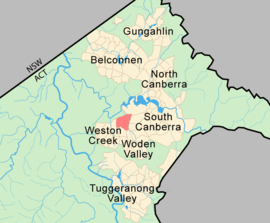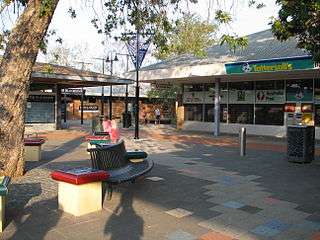Curtin, Australian Capital Territory
| Curtin Canberra, Australian Capital Territory | |||||||||||||
|---|---|---|---|---|---|---|---|---|---|---|---|---|---|
 | |||||||||||||
| Population | 5,175 (2011 census)[1] | ||||||||||||
| • Density | 1,078/km2 (2,792/sq mi) | ||||||||||||
| Established | 1962 | ||||||||||||
| Postcode(s) | 2605 | ||||||||||||
| Area | 4.8 km2 (1.9 sq mi) | ||||||||||||
| District | Woden Valley | ||||||||||||
| Territory electorate(s) | Murrumbidgee | ||||||||||||
| Federal Division(s) | Canberra | ||||||||||||
| |||||||||||||
Curtin is a suburb in Canberra, Australia. Part of the Woden Valley district; its postcode is 2605.
Curtin is named after John Curtin, Australian Prime Minister between 1941 and 1945. Its streets are named after state premiers.[2]
It is next to the suburbs of Yarralumla, Deakin, Hughes, Lyons and Weston. It is bounded by the Cotter road, Tuggeranong Parkway and Yarra Glen.
Curtin shopping centre offers the following services: Coles supermarket, post office, newsagent, bank, real estate agent, TAB, Freshfruit and Vegetables shop and numerous restaurants and eateries. Of note is the Curtin Milk Bar which is the longest running cafe in the area. Its style and format has not changed since the 1970s and is still very popular.[3] Nearby is Curtin Scout Hall.
Large areas of Curtin were designed in accordance with the Radburn model of suburban design and public housing. In Australia, the Radburn model was used in the planning of some Canberra suburbs developed in the 1960s, in particular Charnwood, Curtin and Garran, and a small part of Hughes, however these pockets of Radburn design have not seen the same anti-social and crime-related problems that have plagued similar areas in Western and South-Western Sydney, such as Mt Druitt.
The Canberra bushfires of 2003 destroyed about 4 Curtin homes. Curtin was a suburb that received a small amount of damage in the fires. The Emergency Services Bureau, based in Curtin, which was the centre of command for the firefighting operation, came under threat itself.
Geology
Curtin has much Mount Painter Volcanics dark grey to grey green crystal tuff. Some cream rhyolite is found in the far east along Yarralumla creek, which runs through the edge of the suburb. Sediments such as shale and sandstone are found in the far north east corner north of Yarralumla creek. To the west of Curtin there are horse paddocks that contain sequence of rocks getting younger as you head west. First a band of Mount Painter Volcanics cream rhyolite, followed by a band of Yarralumla Formation calcareous shale, followed by Deakin Volcanics purple and green tuff, and lastly Deakin Volcanics green-grey and purple rhyolite. All of these rock types are from the Silurian age.[4]
Features
Primary Schools
- Curtin primary school [5]
- Holy Trinity Primary School

Pre Schools
- Teddybears Childcare Preschool
- North Curtin Pre School
- South Curtin Pre School
Churches
- Anglican Church of the Good Shepherd
- Holy Trinity (Catholic)
- St James Uniting Church
Housing
- Brindabella Gardens retirement village
Parks
- South Curtin neighbourhood oval
- Illoura Community Horse Holding Paddocks
- North Curtin Horse Paddocks
- North Curtin Oval
Services
- ACT Emergency Services Bureau
- QEII Family Centre
References
- ↑ Australian Bureau of Statistics (31 October 2012). "Curtin (State Suburb)". 2011 Census QuickStats. Retrieved 5 February 2014.
- ↑ "Suburb Name search results". ACT Environment and Sustainable Development. Retrieved 5 February 2014.
- ↑ "Legislative Assembly for the ACT: 2003 Week 9 Hansard (26 August) Page 3219". Hansard.act.gov.au. Retrieved 15 November 2011.
- ↑ Henderson, G. A. M.; Matveev, G. (1980). Geology of Canberra, Queanbeyan and Environs (Map). 1:50000.
- ↑ curtinps.act.edu.au
Coordinates: 35°19′30″S 149°04′40″E / 35.32500°S 149.07778°E